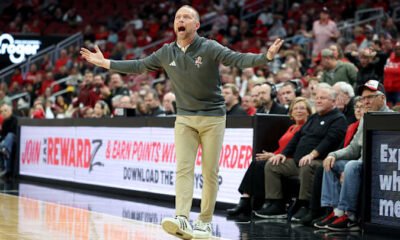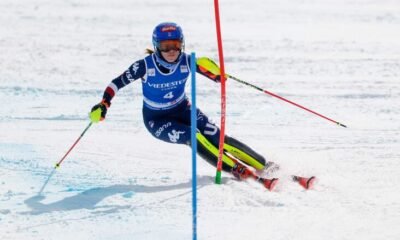Blog
Why Basketballs Are Orange: The Vision of Tony Hinkle from Logansport, Indiana
The distinctive orange color of the modern basketball is often taken for granted, but its origin traces back to one of Indiana’s most influential sports figures, Paul D. “Tony” Hinkle. A native of Logansport, Indiana, Hinkle revolutionized the visibility and design of basketball equipment, leaving a legacy that still impacts the sport today.
Born to Edgar Clayton and Winnie Hinkle, Tony Hinkle displayed athletic promise from an early age. After completing high school at Calumet High School in Chicago in 1917, he enrolled at the University of Chicago. During his college years from 1917 to 1921, he excelled as a three-time letterman in basketball and was named to the Helms All-America team in both 1919 and 1920.
As a college player, Hinkle also helped lead his team to a Big Ten Conference championship in the 1919–20 season. Although they narrowly missed the national title, losing to Penn, Hinkle’s leadership and competitive spirit were already evident. Twice named an All-Big Ten player and team captain, he began establishing himself as a figure destined for coaching greatness.
Hinkle’s journey with Butler University began in 1921, when he joined the institution while it was still located at its Irvington campus. The university would move to its Fairview Park campus in 1928, marking a new era for both Butler and Hinkle’s coaching career.
Over nearly 50 years, Tony Hinkle served Butler as an athletic administrator, teacher, and coach across football, basketball, and baseball. Yet it was basketball where he left his most lasting mark, developing a reputation for leading underdog teams with fearless determination and strategic brilliance.
One of the crowning achievements of his coaching career came in 1929 when he led the Butler Bulldogs to a 17–2 record and a national championship. Under his leadership, Butler earned the nickname “Big Ten killers” for consistently toppling major conference opponents.
Over the course of his career, Hinkle’s basketball teams recorded 560 victories and 392 losses, while his total coaching wins across all sports approached 1,000. These numbers alone speak to his excellence and adaptability as a coach in multiple athletic disciplines.
Yet perhaps his most universally recognized contribution to the sport came in the late 1950s when he addressed a simple but significant problem: basketball visibility. Up until that time, most basketballs were a dull brown, which Hinkle believed made them difficult for players and fans to track during games.
Always a forward thinker, Hinkle envisioned a brighter, more visible ball that would enhance gameplay and viewing. Collaborating with the Spalding Company, he set out to design a ball that could easily be seen from every corner of the court.
The result of this partnership was the now-iconic orange basketball, first introduced at the 1958 NCAA Finals in Louisville, Kentucky. The bright orange hue quickly caught on due to its improved visibility and aesthetic appeal.
The NCAA embraced the new ball, and it wasn’t long before basketball organizations across the country followed suit. Today, the orange basketball is standard at nearly all levels of competition, a tribute to Hinkle’s vision and ingenuity.
Beyond the orange basketball, Hinkle’s influence extended to the very strategy of the game. He developed the “Hinkle System,” an innovative offensive approach built on motion, passes, screens, and picks that became a model for coaches nationwide.
Over 200 high school and collegiate coaches who trained under Hinkle carried his methods into their own programs, spreading his teachings across generations of players and coaches.
Hinkle’s stature in the sport was recognized through numerous leadership positions, including a term as President of the National Association of Basketball Coaches from 1954 to 1955. He also served on the board and chaired the National Basketball Committee’s Rules Committee for the U.S. and Canada.
His contributions were acknowledged with some of the highest honors in the sport, including induction into the Indiana Basketball Hall of Fame in 1962, the Naismith Memorial Basketball Hall of Fame in 1964, and the Indiana Football Hall of Fame in 1974.
On the campus of Butler University, Hinkle’s legacy is physically represented by Hinkle Fieldhouse, formerly Butler Fieldhouse, one of the most iconic basketball venues in America. Renamed in his honor in 1966, it was once the largest basketball arena in the country and famously featured in the movie Hoosiers.
Hinkle remained an integral part of Butler’s athletics program until his retirement in 1970, after 41 seasons as head basketball coach. His life and career continued to inspire long after his passing in 1992.
Today, Tony Hinkle rests alongside his wife, Jane Murdock Stewart Hinkle, at Crown Hill Cemetery in Indianapolis. Yet his legacy lives on in every pass, dribble, and shot made with an orange basketball—a symbol of clarity, innovation, and one man’s enduring love for the game.
-

 Blog5 months ago
Blog5 months agoPat Kelsey sends a strong three-word fiery message to the Louisville basketball’s team after their Cardinals 14th win…
-

 Blog7 months ago
Blog7 months agoNetflix releases “The Underdog,” a much-anticipated documentary about Drew Brees. slated for publication on the 25th
-

 Blog5 months ago
Blog5 months agoMikaela Shiffrin responds to cross-country skier Jessie Diggins’ letter following her failure to secure a solitary podium finish at the FIS Nordic Worlds
-

 Blog3 months ago
Blog3 months agoBehind the Turns: Netflix’s Upcoming Documentary on Mikaela Shiffrin’s Fights, Fears, and Love
-

 Blog4 months ago
Blog4 months agoLegacy Tour Led Zeppelin has officially confirmed their 2026 reunion tour, which will be their first extensive live performances since 2007. The “Led Zeppelin Legacy Tour 2026” will begin on June 10, 2026, at Los Angeles’ SoFi Stadium.
-

 Blog5 months ago
Blog5 months agoWomen’s Slalom Run 1 at the FIS Alpine Skiing World Cup: Are
-

 Blog5 months ago
Blog5 months ago“Courtside to Aisle-Side: Tyrese Haliburton and Jade Jones Set New Wedding Date”
-

 Blog7 months ago
Blog7 months agoFederica Brignone: “I’m fine, but my return to skiing is far off.”
